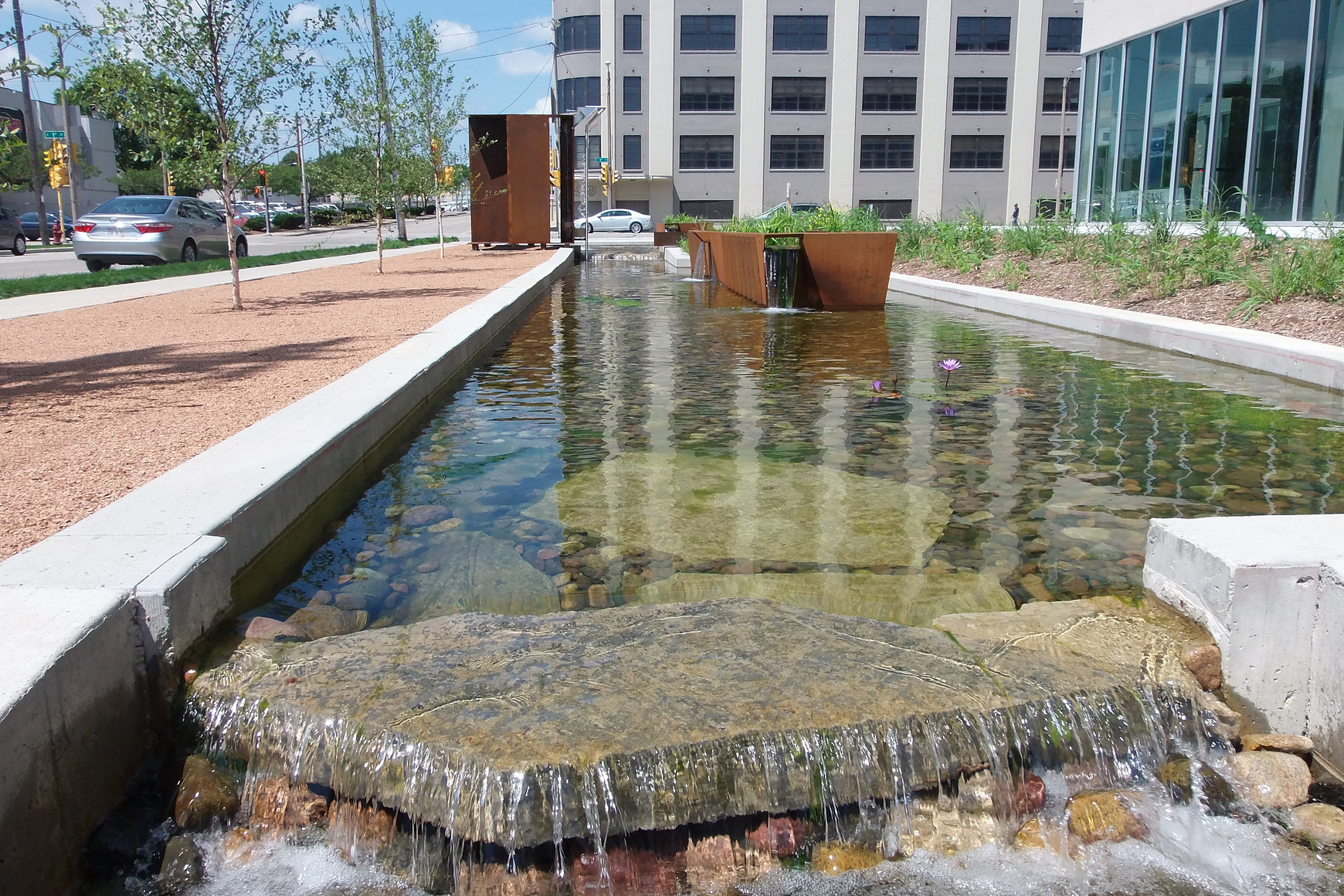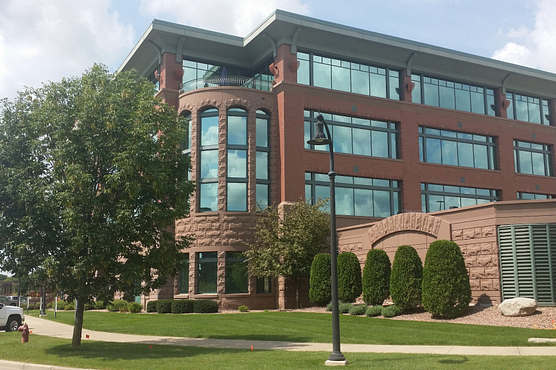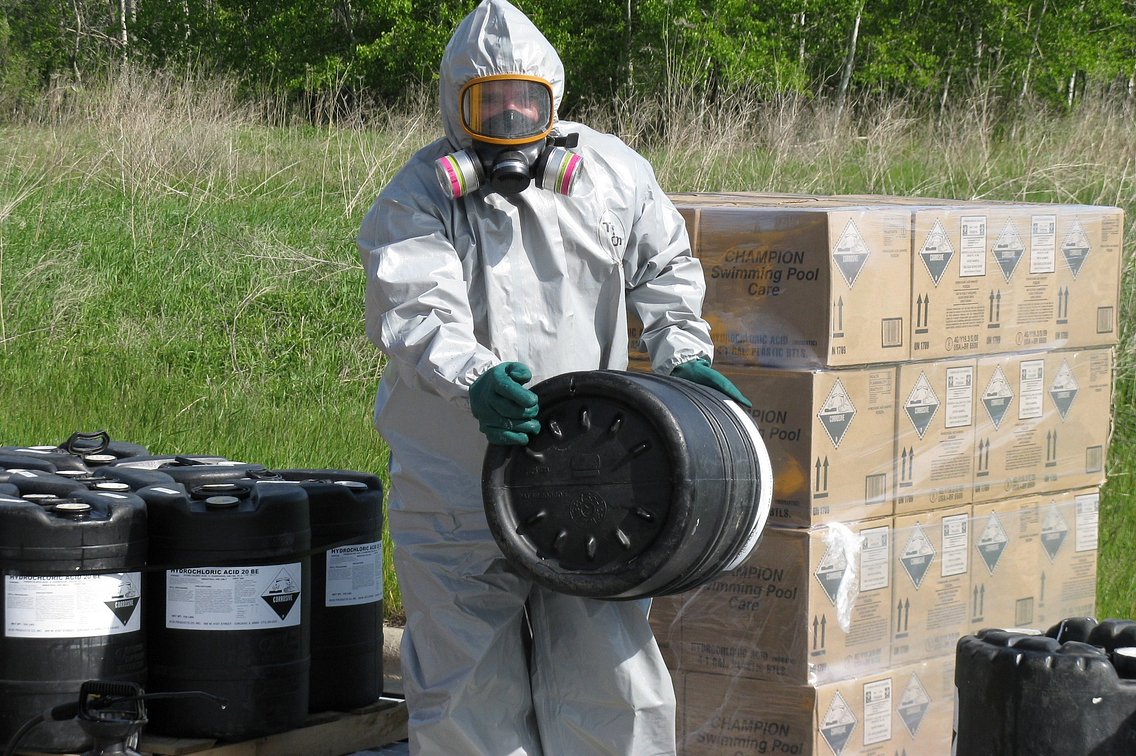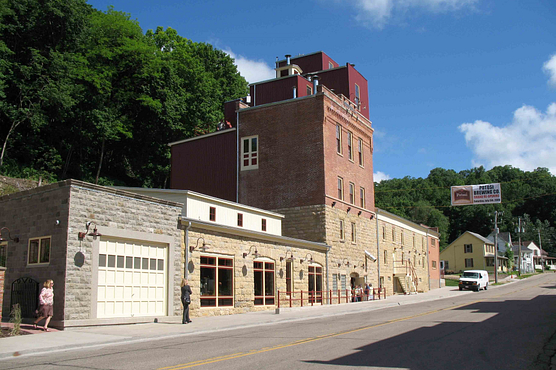Legacy of the spill law
BROWNFIELD SUCCESSES BUILD ON DECADES OF VITAL WORK
Andrea Zani
 Freshwater Plaza in the Walker's Point neighborhood of Milwaukee was built on a former brownfield site.
Freshwater Plaza in the Walker's Point neighborhood of Milwaukee was built on a former brownfield site.© DNR FILES
There is a link on the web page of the DNR's Remediation & Redevelopment (RR) Program simply titled "success stories." Click here and users will find themselves transported to a sort of online scrapbook.
Much like proud parents sharing tales and photos of cherished offspring, the RR program uses this spot to tell about a number of notable community triumphs, special endeavors known as brownfields success stories. It all started 40 years ago with a little law meant to deal with environmental spills — but more about that later.
The brownfields list features some impressive redevelopment projects from around the state. These are significant and sometimes historic efforts that have transformed so-called "brownfields" — abandoned and contaminated lands that sit idle for years — into healthy, vibrant sites well-suited and often ideal for a variety of purposes.
In partnership with community leaders, businesses, other government agencies, concerned citizens and more, the RR program has had a hand in helping to reclaim and revitalize lands that once might have been considered spoiled for good. In fact, since 2005, more than 25,000 acres have been cleaned up and made available for reuse.
Take the Harley-Davidson Museum in Milwaukee, for example, or Tundra Lodge, a waterpark resort and conference center in Green Bay. Both popular tourist destinations are built on former brownfield sites. The aptly named Phoenix Park in Eau Claire, a beautiful nine-acre waterfront park at the confluence of the Chippewa and Eau Claire rivers, rose from a brownfields site that once was home to the former Phoenix Steel Company.
Smaller municipalities benefit, too: The Potosi Brewery in Grant County, with its brew pub restaurant and National Brewery Museum, is a revitalized location now frequented by visitors, as is the Bong WWII Heritage Center in Superior. Prairie du Chien, a Crawford County community of about 5,700 on the Mississippi River, has several remade brownfield sites.
Or how about the Leach Amphitheater in Oshkosh? Opened in May 2005, the scenic spot on the Fox River at Lake Winnebago is home to live music concerts, festivals and many other community and private events. It was only made possible after eight acres of a former manufactured gas plant were restored for use through partnership efforts.
Beyond these impressive redevelopment successes, there is much to note on the remediation side of the RR program as well. Vital environmental cleanup work is facilitated by the program's experts on a regular basis and has occurred in 96 percent of the state's municipalities. Helping to guide the handling of hazardous substance spills and cleanup of contaminated soil and groundwater is critical public health protection work.
But to fully appreciate the story of RR and the ways it works in the community, it is important to understand the program's history. To tell the tales of brownfield transformations and discuss other key cleanup work, it is necessary to go back to the beginning. So let's rewind.
Laying the foundation
We can return to 1995, when the Department of Natural Resources began its Remediation & Redevelopment Program. The program is unique nationwide in its scope, responsible for overseeing all state environmental cleanup programs and many federal laws applied in Wisconsin in conjunction with the U.S. Environmental Protection Agency. This simplified "One Cleanup Program" maintains uniform standards and practices for all remediation efforts.
That same year, 1995, the EPA created the federal Brownfields Program to provide specific regulatory guidelines for brownfield remedies as well as cleanup grants to spur the process.
 In Eau Claire, an area of abandoned and contaminated properties has been reclaimed and includes businesses, apartments and Phoenix Park, an outdoor entertainment venue.
In Eau Claire, an area of abandoned and contaminated properties has been reclaimed and includes businesses, apartments and Phoenix Park, an outdoor entertainment venue.© DNR FILES
A year before that, Wisconsin took a monumental step forward when it implemented the Land Recycling Law. This major state legislation promoted a new outlook on land reuse by establishing strategic liability exemptions and a state loan program to help local governments, land owners and lenders work together. Related legislation in 1998 established the Brownfields Study Group to independently evaluate policy initiatives and funding issues.
Before that, in the late 1980s, Wisconsin's passage of the Petroleum Environmental Cleanup Fund Act (PECFA) addressed problems involving underground petroleum storage tanks. And the early '80s saw key pieces of state legislation in the Groundwater Protection Act, the Abandoned Landfill effort and the Environmental Repair Law, which provided state funds for cleanups when the party legally responsible to take action was not available.
On the federal level, the EPA created its Superfund program in 1980 to address cleanup of the nation's worst hazardous waste sites, prompted in large part by New York's infamous Love Canal neighborhood chemical contamination tragedy. Other legislation and initiatives, both state and federal, have been mixed in along the way.
But to really understand the foundation for the environmental protection work guided by the RR program, 1978 is the year. It was then, 40 years ago, that the cornerstone of four decades of cleanup and redevelopment capability was put into place.
That first step in the enduring process that has led to so many statewide success stories was Wisconsin's passage of a simple yet highly effective piece of legislation. Suffice it to say, it all started with the Spill Law.
Quick action for spills
The Hazardous Substance Spill Law is part of the broader Wisconsin Statute Chapter 292, which addresses environmental cleanup issues. The Spill Law requires anyone who causes, possesses or controls a hazardous substance that was discharged into the environment to take action to restore the affected air, land and waters. Immediate reporting to the DNR is required, and the law applies equally to a recent spill or to old contamination newly discovered.
This call for prompt notification is key because it allows the DNR and local responders to take quick action to evaluate a spill and address immediate risks that might be associated with the discharge. RR staff then begin the process of overseeing any additional work needed to ensure health and safety protections.
 Brownfield site remediation sometimes includes removal of hazardous chemicals.
Brownfield site remediation sometimes includes removal of hazardous chemicals.© DNR FILES
The Spill Law was Wisconsin's response to years of dealing with spills, leaks and dumping of any number of hazardous substances, from chemicals used in industrial processes, to solvents used for dry cleaning, to fuels such as petroleum and gasoline. Even seemingly harmless substances like corn and butter can cause a problem if spilled in enough volume in the wrong place.
The law greatly improved DNR's ability to assess and address hazardous spills and issues of property contamination, providing the authority needed to protect natural resources and public health. Better environmental and public health is the result.
"I think the history of the Spill Law will show or has shown that it addressed tens of thousands of contamination sites, large and small, simple and complex, throughout the entire state in a way that was relatively consistent and protective," said Mark Giesfeldt, retired director of DNR's RR program.
Chris Saari, a hydrogeologist who is the Northern Region Team Supervisor for RR, also cites the direct benefits the law has had on people around the state.
"I guess the biggest impact is just seeing the positive effects that we've had on properties, especially ones where we've had situations where people's drinking water has been affected and we've been able to come in and help them," Saari said. "You know, nobody wants to go to the northern Wisconsin supper club and wonder what's in the ice cubes in their old-fashioned."
Following passage of the Spill Law in 1978 and a decade focused on landfills and leaking storage tanks, state administrative rules known as the NR 700 series were developed in the 1990s to provide comprehensive guidelines for dealing with contaminated properties. These rules provide a roadmap for responsible parties and their consultants to obtain cleanup approval from the DNR. They are set up deliberately to empower vested partners such as businesses, local governments and communities to be in control of their sites, while still ensuring adequate oversight.
"It makes our partnership approach to cleanups even more important," said DNR's Brownfields Section Chief Christine Haag. "It's the opposite of 'command and control.' Outreach, training and collaboration have been a cornerstone of the RR program, arming the people involved in these projects with information they need to complete cleanups and move forward."
About those brownfields
The environmental and public health benefits of the state Spill Law have now been felt for decades and more recently, economic benefits are coming to light. Perhaps nowhere are these effects more visible than when it comes to brownfields. The remediation and redevelopment of brownfield properties is very often tied to increased property values, jobs and other economic gains.
A 2015 study commissioned by the Brownfields Study Group and conducted by the UW-Whitewater Fiscal and Economic Research Center found that state brownfield grants to municipalities from 1998-2014 generated $4.4 billion in direct economic output. Such grants also catalyzed the development of 9.6 million square feet of new or renovated industrial buildings and accounted for 29,500 direct new and retained permanent jobs, the study showed.
In La Crosse, for example, the Riverside Redevelopment Project dating to the mid-1990s, which included a new CenturyTel Inc. (now CenturyLink) headquarters, is credited by project partners with increasing property values and both retaining and creating jobs.
In Milwaukee's Menomonee Valley, the redevelopment of brownfields has brought back more than 5,000 jobs, according to a report from Menomonee Valley Partners, a nonprofit private-public group formed to facilitate redevelopment efforts there. In the past 10 years, the partnership group notes, 39 companies have moved to or expanded businesses in the Menomonee Valley. Combine that with revitalization projects such as the Hank Aaron State Trail, and the benefits to the area are enormous.
"It's an economic, environmental and public health success story for the state," said Dave Misky, co-chair of the Brownfields Study Group and assistant executive director for the Redevelopment Authority of the City of Milwaukee.
In Milwaukee and other cases, reclaimed areas have become integral parts of a city's revitalization. Examples include Kenosha's Harbor Park on Lake Michigan, the Plexus Corporate Headquarters on the banks of Little Lake Butte des Morts in Neenah, and the East Riverfront Redevelopment Area in Wausau, which features more than 16 acres of waterfront undergoing redevelopment for entertainment and commercial uses and public green space.
 The historic Potosi Brewery building was restored and reopened in 2008 as a tourist attraction that includes a brew pub, gift shop and the National Brewery Museum.
The historic Potosi Brewery building was restored and reopened in 2008 as a tourist attraction that includes a brew pub, gift shop and the National Brewery Museum.© DNR FILES
In Ashland, on Lake Superior, brownfields work beginning in the late 1990s also transformed much of the downtown. Saari, the DNR hydrogeologist, is a native of Ashland and has a special connection to the redevelopment aided by the Spill Law there.
"It was multiple projects, but it was all within the center of the city of Ashland," he said. "I grew up in Ashland, I grew up around these areas. There were two railyards and two bulk petroleum facilities. We had a hand in cleaning all four of those properties up.
"Now that's sort of the centerpiece of Ashland. There are baseball diamonds there, there's a community center in that area, one of the main grocery stores was built on one of the old railyard properties. When you drive through Ashland on Highway 13, you're driving right by it and if you saw it now as opposed to what it looked like in 1991, it's so much nicer. And it's all because of the abilities that we were able to bring with the Spill Law."
Wide-ranging renewals
Uses of restored brownfields sites are vast and varied — everything from hospital expansion, retail shopping centers and grocery stores to apartments and townhomes, premier soccer complexes, senior housing and college residence halls. Even public service buildings such as the Platteville Police Department and the Amery Fire Station are on former brownfield sites.
Some areas are cleaned up for the sole purpose of creating greenspaces. In the town of Shields, for example, an open spot near the scenic Mecan River once was a blighted eyesore, a former scrap yard and dairy creamery before that, which had posed a number of environmental hazards and safety issues. What a difference brownfields work made there! Elsewhere around the state, there also are a variety of parks and recreational trails where cleanups took place.
Sometimes even cleanups of what might seem like tiny spaces can make a difference. Seven Mile Creek Park in Lamartine, for instance, checks in at just over one acre. And in Seymour, Veterans Memorial Park is even smaller than that, less than a half-acre.
Urban or rural, large or small, all around Wisconsin these former brownfields have been reborn.
Partnerships and funding
In both the remediation and the redevelopment sides of RR, working with people and entities across the board is vital to achieving desired results. Brownfields revitalization is a team effort. Cooperation with everyone involved is critical.
Local governments, especially, are major players in cleanup and redevelopment, with city, town and county leaders playing a huge role and often paving the way for successful community projects. Property owners, environmental experts, service contractors, developers, lenders and a host of others are integral to the process as well.
"It truly takes a village to clean up and redevelop a brownfields site," said Darsi Foss, director of DNR's RR program. Communication among all the players in a project is key, added Trevor Nobile, a DNR hydrogeologist who works with brownfields. And that's where DNR's RR program can play an important role.
"Essentially, it boils down to effective communication and building those relationships with the local municipalities, consultants, other project managers, other DNR programs — develop those positive relationships and achieve that common goal," he said.
In addition to crediting the many other partners who work with DNR on brownfields, it would be an oversight not to mention again the Brownfields Study Group. Like the Spill Law, the BSG also is celebrating an anniversary — it has been 20 years since the independent advisory group was created to provide guidance to the State Legislature and the DNR on brownfields policy. The sustained work of this group of expert volunteers has been immensely valuable (see sidebar).
 Brownfields Study Group: at left on stairs, back to front, are Scott Wilson, Nancy Frank, John Stibal, Bruce Keyes, Karen Dettmer and Dave Misky. Center is Sam Tobias; and at right, back to front, are Geoff Simering, Arthur Harrington, John Antaramian, Lynn Morgan and Mark Thimke.
Brownfields Study Group: at left on stairs, back to front, are Scott Wilson, Nancy Frank, John Stibal, Bruce Keyes, Karen Dettmer and Dave Misky. Center is Sam Tobias; and at right, back to front, are Geoff Simering, Arthur Harrington, John Antaramian, Lynn Morgan and Mark Thimke.© MICHAEL SKWAROK
The efforts of the BSG, determined local officials, private partners and intrepid developers are, alone, sometimes not enough to accomplish revitalization work; state and federal funding can be instrumental for success. Through the years, the RR program has managed a number of grant and loan programs to spur brownfield cleanups and redevelopments.
And the program offers other financial and technical expertise as well — even tools to help handle targeted properties with unpaid back taxes fall under the program's scope.
The BSG-commissioned economic study mentioned earlier found that every $1 of state funding for brownfields work was repaid 14 times over by new tax revenue from the resulting developments. Municipalities have benefited, and it hasn't gone unnoticed.
John Antaramian, Kenosha mayor and Brownfields Study Group member, has much praise for the work of the BSG and the RR program.
"There are a whole bunch of people in the DNR and in the brownfields program that have stepped up to the plate and made things happen. I guess I can't put emphasis enough on that," he said. "You make things happen, that's what makes you so important. Because you don't say, 'Oh, we can't do this because ...' It's, 'OK, how do we get it done? How do we make it work? How do we make it safe and how do we make the development happen?'
"And I think that kudos go out to all the members of the brownfield group and all the hard work that they do."
Kenosha is a better place because of brownfields work, Antaramian added.
"I would like to say thank you to all the folks at the DNR, and especially brownfields, for all the work they've done," he said, "because Kenosha would not be where it is today had it not been for all of you."
From contaminated to cleaned up, and from rundown to revitalized, the Spill Law started it all 40 years ago. This simple statute continues to pay big dividends for health and prosperity in Wisconsin.
Andrea Zani is managing editor of Wisconsin Natural Resources magazine. Christine Haag, Barry Ashenfelter and Darsi Foss of the RR program contributed to this story. Some of the comments included are from interviews conducted earlier this year for a DNR video, "Wisconsin's Spill Law 1978-2018: 40 Years of Places, Partnerships & People."
BY THE NUMBERS
In the past 40 years, Wisconsin's Spill Law has guided successful resolution of thousands of spill cases statewide.
- 28,856 total case closures granted
- 30,942 spills with no further action needed
- 25,132½ acres returned for reuse
For more about the work of DNR's Remediation & Redevelopment Program, check Environmental cleanup & brownfields
BROWNFIELDS STUDY GROUP MARKS 20 YEARS OF SUCCESS
Twenty years ago, the Brownfields Study Group was created at the direction of Gov. Tommy Thompson and the State Legislature to examine Wisconsin's ongoing brownfields efforts and make recommendations. Thirty of the group's initial proposals were adopted and that success prompted a continuation of the volunteer group of professionals, which now meets three to four times each year.
Group members have included local government and university officials, industry professionals, legal experts, conservation group members and others. Over the past two decades, this independent advisory group has driven important changes in brownfields work, particularly when it comes to incorporating incentives for cleanup and reuse of properties statewide.
It wasn't always easy, said Mark Thimke, an attorney and co-chair of the Brownfields Study Group. Brownfields redevelopment could seem like a daunting task and the group worked hard to get projects moving ahead.
"When we first started out, brownfields was not the active program it is today," Thimke said. "Most people refused to engage in doing any kind of brownfield projects because of the huge liability concerns. And so we had to tackle the effort of showing to the investment community and to the real estate development community and to local government that you could take this kind of property and you could put it back into productive use. And just being able to develop those tools was very important."
Art Harrington, attorney and member of the Brownfields Study Group, credits the DNR with forward-thinking in fostering a private-public model that has proven effective.
"At the time this was formed, this was something new that I think the department was being innovative by reaching out into the private sector and municipalities to bring them in for advice," he said. "It was a very, very new concept and I give the department a lot of credit when they came up with this idea.
"This thing is one of the first longstanding advisory committees that the department has used and I just think it is a terrific model for a collaborative working relationship that has now existed for 20 years."
A variety of initiatives count among the successes of the Brownfields Study Group including:
- The Voluntary Party Liability Exemption program, allowing those involved in property cleanup to obtain assurance against future liability for past contamination. By addressing risk management, it can help spur private developers to take on problem sites.
- Wisconsin Plant Recovery Initiative, helping communities and businesses to turn around closed or closing manufacturing facilities.
- Brownfields Site Assessment Grant Program and Brownfields Green Space and Public Facilities Grant Program, two state programs that over the years have awarded millions of dollars in community grants for cleanup efforts.
- Ready for Reuse Grants and Loans, one of the programs accounting for more than $18 million in federal dollars the study group has helped secure for Wisconsin cleanups.
- One Cleanup Program Agreement, a comprehensive agreement between the DNR and EPA Region 5 to help expedite cleanups of contaminated properties in the state.
The Brownfields Study Group also commissioned the 2015 study by the UW-Whitewater Fiscal and Economic Research Center, which demonstrates the positive economic impact of brownfields investments in Wisconsin. The DNR continues to work in partnership with the BSG to advance remediation and redevelopment efforts in the state.
"We appreciate the extraordinary effort this group has made to ensure Wisconsin's brownfields program is effective," said Christine Haag, DNR's Brownfields Section Chief. "If you've seen an old, abandoned industrial property in your community find new life as a park, coffee shop, brewery or housing development, chances are this group had something to do with creating the mechanisms that helped make that happen."
— Andrea Zani

